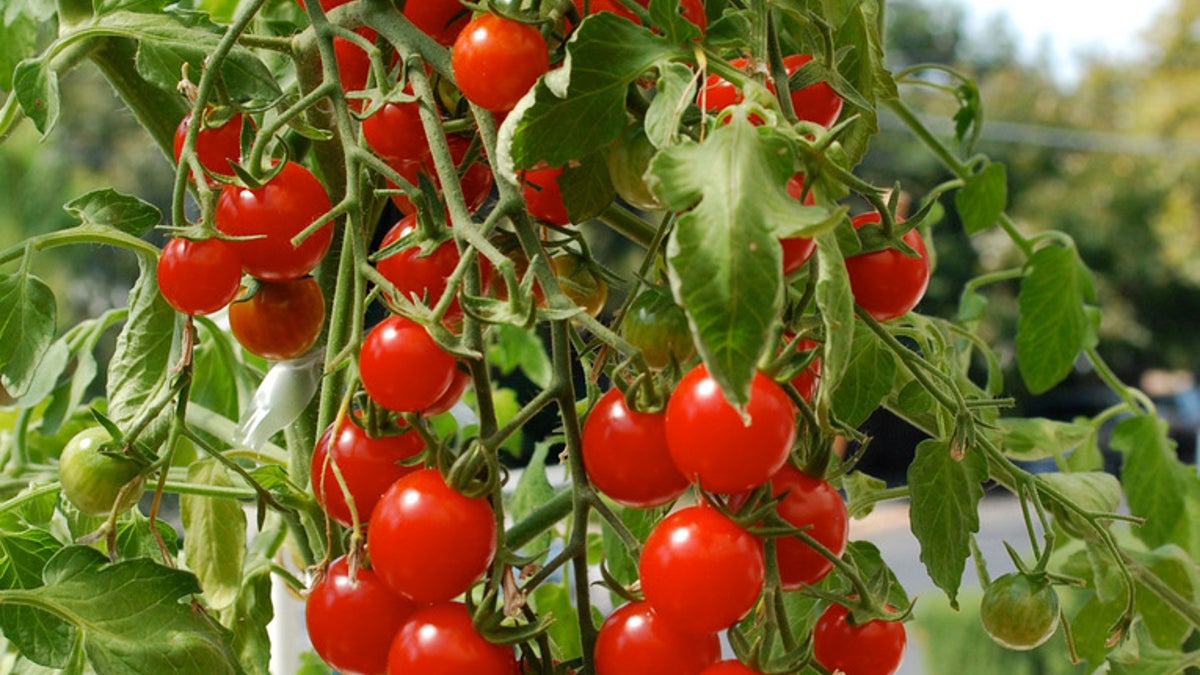
Cherry tomatoes have been loved by vegetable gardeners since the beginning of the 20th century. This year, why not make the most of their fast-growing foliage and brilliantly colored fruits outside of the vegetable garden, and let them take center stage? They can brighten your garden from spring through first frost and are proof that edibles can mix easily with ornamentals in a landscape.
RELATED: Tomato Season Meets a Family Legacy
Botanical name: Solanum lycopersicum var. cerasiforme
Common names: Cherry tomato, grape tomato
Origin: Mexico, with ancestral roots in South America
Where they will grow: As an annual, cherry tomatoes grow well in almost any location; choose varieties that do well in your region if you have cool summers or extended humidity.
Water requirement:Regular
Light requirement: Full sun
Mature size: Given support, some varieties can reach 8 feet tall or taller
When to plant: Sow seeds or set out seedlings in spring when the soil has warmed up, night temperatures have reached 50 degrees Fahrenheit (10 degrees Celsius) and all danger of frost has passed; start seeds indoors five to eight weeks before your planned planting date, especially if your growing season is short.
Why grow them? Cherry tomatoes are among the easiest tomatoes to grow, and varieties can be found for almost any growing condition. They’re generally prolific producers with tasty fruit that can be eaten out of hand or used for cooking. They’re also a good choice for smaller gardens, patios and decks.
Distinguishing traits. The fruit’s colors include the common reds and yellows, but there are also cherry tomatoes that are green, purple, black and ivory. Most are round, but oval and pear-shaped cherry tomatoes are available.
Favorite varieties. The possibilities seem endless; some of the most popular cherry tomatoes include ‘Sweet 100’, ‘Supersweet 100’, ‘Sweet Million’, ‘Sun Gold’, ‘Sun Sugar’ and ‘Sugar Snack’ — you may notice a trend.
There’s no reason to stop with these. Other cherry tomatoes that are gaining fans include Black Pearl, ‘Chello’, ‘Cherries Jubilee’, ‘Dr. Carolyn’, ‘Green Grape’, ‘Gardener’s Delight’, ‘Honeybunch Cherry’, ‘Husky Cherry’, ivory-colored ‘Italian Ice’, ‘Matt’s Wild Cherry’, ‘Napa Grape’, ‘Purple Haze’, ‘Snow White’, ‘Sun Cherry’ and ‘Yellow Pear’.
Determinate versus indeterminate. Cherry tomatoes labeled “determinate” will grow only to a certain height and need less support. They tend to produce fruit only once during a growing season. Indeterminate varieties will keep growing as long as you let them, making them a good choice for a trellis, an arbor or a pergola. They also produce fruit throughout the growing season.
How to use them. Of course, cherry tomatoes are at home in a vegetable garden, but their thick foliage — which easily climbs a support — along with their bright colors makes them a great addition to an ornamental landscape as well. Grow them over a trellis or pergola, use them as a backdrop along a tall fence or wall, or plant in containers that can be interspersed with ornamental plants. They’re also a good choice for container gardens on patios and decks.
Planting notes. Tomatoes will need two to three months of hot weather to do well, although some varieties are bred to handle cooler weather. If summers are short, start seeds indoors or look for seedlings in nurseries.
Sow seeds or set seedlings in full sun in well-draining, neutral to slightly acidic soil. Before planting seedlings, remove the bottom two sets of leaves. Set plants in soil up to the bottom of the lowest remaining leaves.
Add supports when you plant. Use soft ties to attach the stems to the supports.
Tomatoes need room for their roots, so containers, even for cherry tomatoes, should be large. A 20-gallon container is ideal, but you can go slightly smaller with cherry tomatoes.
RELATED: Pull Up More Dining Room Chairs to Share Your Harvest With a Crowd
Care and feeding. Water regularly and deeply, then let the soil dry out between waterings. Be consistent with your watering schedule for the best results.
If your soil is poor, feed every other week with a quarter-strength low-nitrogen fertilizer once the blossom has formed.
Problems and pests. Tomatoes are, unfortunately, subject to a number of diseases and pests. Diseases are probably the most common issue for gardeners, especially viruses and wilts. If specific diseases are a problem in your area, look for labels with the abbreviations below. The abbreviations indicate that the plant has been bred to resist these problems. As a preventative measure, rotate planting spots on a three-year cycle.
- A: Alternaria leaf spot
- F: Fusarium wilt
- FF: Race 1 and race 2 of fusarium wilt
- L: Septoria leaf spot
- N: Nematodes
- T: Tobacco mosaic virus
- V: Verticillium wilt
Pest problems include the usual subjects, including aphids, beetles, cutworms, leafminers, melon flies, whiteflies and tomato hornworms. Keep an eye on your plants and apply preventative measures early. Placing collars around seedlings can thwart cutworms, and tomato hornworms can be picked off the plants.
Harvest. Cherry tomatoes are ready to eat when they easily slip off the stem. Pop them into your mouth immediately or use them for salads, appetizers and garnishes.